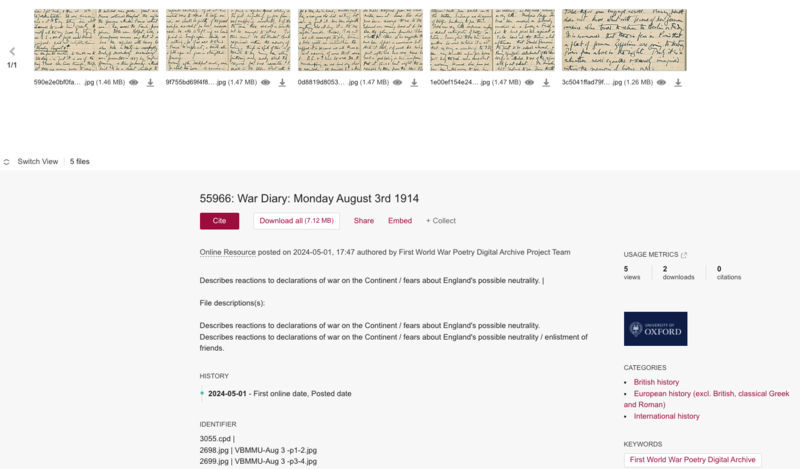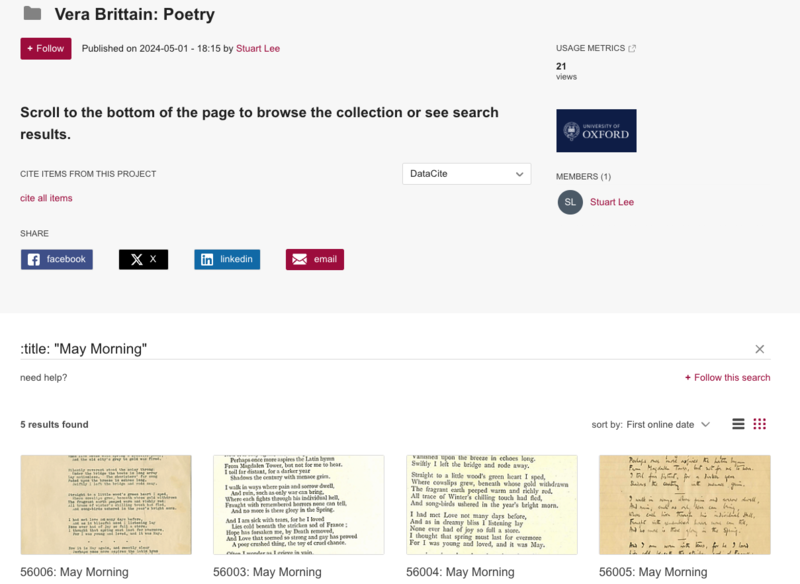Robert Graves
War was return of earth to ugly earth, / War was foundering of sublimities, / Extinction of each happy art and faith / By which the world had still kept head in air’
Recalling War (l. 31–34)
Biography
https://widgets.figshare.com/articles/25552176/embed?show_title=1Robert Graves (1895–1985)
Robert Graves was born in 1895 in Wimbledon to Alfred Perceval Graves, a man of letters and school inspector of Anglo-Irish and Scots descent, and Amalia von Ranke, the niece of the great German historian Leopold von Ranke. In his autobiography Goodbye to All That (1929), Graves describes early visits to his German cousins’ estate, and recounts his unhappy years at Charterhouse School, where he first became involved in writing and editing poetry. At school he also won cups for boxing, and over the course of holidays spent at Harlech in North Wales he developed an interest in mountain climbing.
When war was declared in August 1914, Graves enlisted immediately, despite having secured an exhibition to St John’s College, Oxford. This meant that he went straight from school into the Royal Welch Fusiliers. In Goodbye to All That he records his respect for the history of the regiment and its superb discipline, as well as his discomfort at having secured a commission despite his lack of military experience. He served in France from 1915 – he was made a captain in October that year – to 1917. It was there that he began his friendship with the poet Siegfried Sassoon, a fellow-Fusilier.
On 20 July 1916 during the Battle of the Somme – four days before his twenty-first birthday – Graves was struck by a shell fragment, a piece of which passed through his shoulder and chest, seriously injuring his right lung. He was taken to a dressing-station, and next morning was reported to have died. The Times even printed his name in the list of war dead, later correcting this when it became known that he had survived his wounds and was convalescing in England. Damage to his nerves and general health meant that his return to France in 1917 was not for long, and he spent the remainder of the war in various posts in England and Ireland.
During the war he became increasingly involved in his poetry. Encouraged by Edward Marsh, private secretary to Winston Churchill and editor of the Georgian Poetry anthologies, Graves published his first volume, Over the Brazier, in 1916, and Fairies and Fusiliers in 1917. He maintained a regular correspondence with Sassoon, discussing poetry, their regiment and war in general. When, in 1917, Sassoon determined to make a public statement condemning the prolongation of the war, Graves interceded and convinced the military authorities that his friend was suffering from nerves. As a result, instead of a court martial Sassoon was sent to Craiglockhart War Hospital near Edinburgh. Graves visited him, and there they both became friends with the poet Wilfred Owen. In January 1918 Owen attended Robert Graves’s wedding to Nancy Nicholson, daughter of the painter William Nicholson.
Following the Armistice on 11th November 1918, Graves resigned his commission and took up his fellowship at St John's College, where he met T. E. Lawrence, who was then at All Souls College. He and Nancy set up a small grocery in Boars Hill to support their growing family, but the business soon failed. Graves carried on attempting to earn money by his writing. In 1926 he accepted a post at Cairo University, but stayed there for only six months with his wife and their four children. The American poet Laura Riding accompanied them.
In 1929, his marriage having come to an end, Graves left England with Laura Riding and settled in the mountain village of Deià in Majorca, Spain. There they published a variety of books, especially their poetry, through their Seizin Press. Graves’s commercially successful biography of T. E. Lawrence had appeared in 1927. Goodbye to All That (1929), which also proved a bestseller, aroused considerable controversy, and caused a lasting break with Sassoon. In 1934 he published his classic historical novel I Claudius, another bestseller, followed by Claudius the God (1935).
At the outbreak of the Spanish Civil War in 1936 Graves and Riding returned to London, and then moved in 1939 to New Hope, Pennsylvania, where their relationship finally broke down. After returning later that year to England, Graves lived in Devon with Beryl Hodge, wife of Alan Hodge, who collaborated with Graves on various literary projects. In 1946 Graves went back to Majorca with Beryl, and the couple, who had four children, eventually married. Graves published in 1948 The White Goddess, his celebrated ‘historical grammar of poetic myth’ detailing his view of the ‘poetic impulse’; The Greek Myths appeared in 1955. From 1961 to 1965 Graves was Professor of Poetry at Oxford, and in 1971 he was made an honorary fellow of St John’s College.
Robert Graves died at the age of 90, and is buried at Deià in the small cemetery overlooking the sea.
| Author | Alisa Miller. Edited by Dunstan Ward. |
|---|---|
| Sources |
|
The Robert Graves Collection
User Guide for the First World War Poetry Digital Archive on Oxford University's SDS Platform
The SDS (Sustainable Digital Scholarship) platform, powered by FigShare, is a robust digital repository used by Oxford University to host a wide range of academic content. It ensures long-term preservation and accessibility of scholarly resources. This user guide will help you navigate the First World War Poetry Digital Archive stored within this platform.
Navigating the Archive
-
Select a Category below: Begin by choosing a category from the available tabs below, such as poetry, correspondence, etc. This selection will link you to specific types of documents within the archive.
-
Accessing Items: Once you click on an item, a new tab will open in your browser directing you to the SDS page containing the selected record. If there are multiple versions of an record, such as a manuscript and a typescript of a poem, the link might direct you to a search result page on SDS where all versions are listed.
-
Example of the page directly to the record:

-
Example of the page when there are multiple versions of a record:

-
-
Browsing Collections: Besides specific searches, you can also browse the entire collections on the SDS platform. This feature allows you to explore additional materials that may not be directly linked to but are part of the First World War Poetry Digital Archive.
Please Note:
- Accessibility: Archive files from recent years are accessible using assistive technologies. Older files, particularly those scanned from original printed volumes, may not be fully accessible and are recommended to be downloaded for optimal viewing.
- Access Restrictions: Some documents, especially those containing sensitive information, are only available to university members through a single sign-on account. Publicly available files can be accessed without such restrictions, adhering to data protection guidelines.
- Assistance Requests: For specific access needs or inquiries, such as obtaining content in accessible formats or accessing restricted files without a single sign-on, please contact the appropriate administrative support via email.
Citing and Downloading Records
- To cite an item, click the 'Cite' button under the item's title in SDS. See below:

- Download Options: You can download files directly from the SDS platform. This is recommended for large files or when a detailed review of documents is required.



